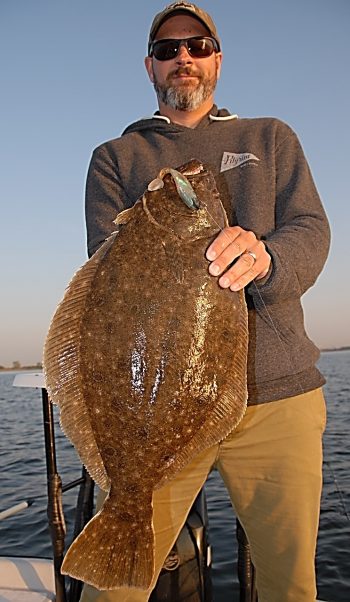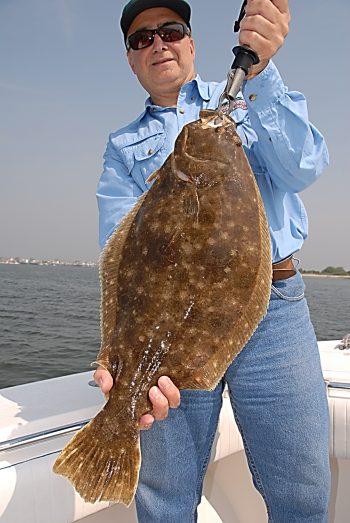Some may be cheering the Secretary of Commerce’s decision to overrule ASMFC on summer flounder, but in the end, Jersey may have really screwed us
If you are a regular reader, you likely know the controversy surrounding summer flounder (aka fluke). And I’m guessing you’re probably up to speed on the striped bass situation, too (more on this later).
We’ve written about both quite a bit here… But to sum things up, the summer flounder stock has been on a steady downward trend for quite some time now. While it is not yet technically “overfished,” it certainly appears to be headed that way.
Those folks who have wanted to avoid any sort of conservation (in other words, the necessary implementation of constraining measures that would keep the stock from becoming “overfished”) have argued that there are plenty of fluke around, and that the 13 or so different surveys and all the accompanying science is simply wrong.
As we get into the heart of summer flounder season this year, it’s getting hard to listen to that kind of thing with a straight face. Sure, there are still pockets of good fishing here and there… But overall, I think you’d find it hard to find any reasonable fluke angler outside of Montauk who would tell you that things are okay.
The point is that it was very clear that we couldn’t keep fishing for fluke at the rate we were, without pushing it into that “overfished” range.
So… the Atlantic States Marine Fisheries Commission (ASMFC) did what is had to do. After much debate between states, it implemented measures that would reduce the number of fish harvested by both the recreational and commercial side by some 30%, implementing regional measures that were constraining, but not catastrophic, IMO. New Jersey, New York and Connecticut retained a full season, but needed to reduce their bag limit from 5 to 3 fish and up their size limit from 18″ to 19″.
Of course, New Jersey freaked out. They simply couldn’t live with a 19″ size limit, and I get that. Presumably the southern portion of the state doesn’t get those larger fish.
But the reality is that no state “liked” the new regs.
Still, they all agreed (except for one state, Jersey) and eventually voted in what they felt was the best possible option to avoid overfishing while maintaining reasonable access… knowing that they probably wouldn’t go over well back home, but also knowing that they were necessary if we were to avoid having fluke slip into an overfished state.
And I would note here that if fluke do become “overfished,” then the feds would need to implement a rebuilding plan. And you think we have constraining measures now? They will be much worse if the stock becomes overfished!
New Jersey out of compliance with ASMFC
New Jersey essentially gave ASMFC the middle finger and implemented its own regulations independent of the Commission, so that they could continue to fish on 18″ fish, instead of the 19″ size limit ASMFC had implemented.
Back in early June, the ASMFC found the State of New Jersey out of compliance.
Shortly thereafter, it forwarded notice of such a finding to the US Commerce Department, which would presumably impose a moratorium on summer flounder fishing off New Jersey until the state adopted regulations consistent with the management plan.
But that didn’t happen… Just last week, the Commerce Department announced that it was overruling ASMFC’s decision to find the state out of compliance.
This is a BIG deal. There had been non-compliance findings before, but Commerce had never overruled one. And I hate to say it here, but it certainly seems that that this was a political decision, not one based on science.
The stark reality is that this puts the whole idea of ASMFC and cooperative, interstate fishery management very much in doubt.
And certainly, it would seem to put striped bass, menhaden as well as a host of other recreationally important species into a sort of jeopardy that had not existed for nearly a quarter-century.
Without cooperative management, managers would have never rebuilt striped bass
To understand the threat all this poses to the East Coast’s inshore fisheries, you’ve really got to understand the history of striped bass.
A good 40 years ago, the striped bass population had more or less collapsed. There were some initial attempts to correct the situation. But, back then everything with inshore fisheries like striped bass was done at the state level. And so there was a “Tragedy of the Commons” sort of situation.
Individual states of course were reluctant to implement measures that constrained harvest in their states as it would disadvantage their own fishermen, while allowing striped bass to survive long enough to continue their migration and be caught in the waters of neighboring states.
While ASMFC had been chartered way back in 1942, and was certainly active throughout the 1970s, it really only played advisory role back then. It had no authority to make states to comply with any management plan.
ASMFC adopted its first striped bass management plan in 1981, but it was largely ignored, at a time when striped bass had pretty much tanked.
So a small but significant group of passionate fisherman voiced their concerns about the future of the fishery, and eventually gained the ear of Congress.
In 1984, Congress passed the Atlantic Striped Bass Conservation Act (Striped Bass Act), which gave ASMFC real fisheries management authority.
It required every state to adopt regulations consistent with ASMFC’s striped bass management plan, and provided ASMFC with a mechanism to enforce its management decisions.
Should any state not enforce the provisions of ASMFC’s striped bass management plan, the Commission would report such noncompliance to the Secretaries of Commerce and the Interior; if they agreed that the state was out of compliance, they were required to impose a moratorium on all striped bass fishing in the noncompliant state until, of course, that state took action to come back into compliance.
Thanks to the Striped Bass Act, ASMFC was able to garner the cooperation of every state between Maine and North Carolina, and convince them to adopt the constraining measures needed to successfully rebuild the striped bass population. As a result, in 1995, the striped bass population was declared to be fully restored.
Congress built on that success, passing the Atlantic Coastal Fisheries Cooperative Management Act (Cooperative Act) in 1993. That law gave ASMFC the ability to enforce the provisions of all of its fisheries management plans through the threat of a federal moratorium.
Getting back to summer flounder
So, ASMFC invoked the provisions of the Cooperative Act when it found New Jersey’s summer flounder regulations to be out of compliance, and notified the Commerce Department of such finding.
New Jersey couldn’t credibly argue that it was in compliance with ASMFC’s summer flounder management plan.
New Jersey argued that it didn’t need to adopt the ASMFC-mandated regulations, because its regulations had the same conservation impact as ASMFC’s management plan.
It based that argument on the theoretical difference in discard mortality—the number of undersized fish that die after being released—between its regulations and those required by ASMFC.
ASMFC’s management plan would reduce New Jersey’s recreational summer flounder landings by about 33%. However, the state claimed that the one-inch increase in the size limit would significantly increase both the number of fish being released and the resultant discard mortality. According to New Jersey, when both landings and discard mortality were considered, the ASMFC management plan would only reduce the number of summer flounder killed by 14%.
On the other hand, New Jersey maintained, the state’s regulations only reduced landings by 24%, but they also reduced discard mortality so that, when the two factors were combined, about 30% fewer summer flounder would be killed, making New Jersey’s regulations “conservationally equivalent” to ASMFC’s management plan.
That sounds reasonable, but ASMFC’s Summer Flounder, Scup and Black Sea Bass Technical Committee rejected New Jersey’s argument, because in the end, New Jersey just didn’t have the science to show “conservation equivalency.”
But the Commerce Department said “New Jersey makes a compelling argument,” and found them to be in compliance.
Do I think New Jersey’s proposal will be catastrophic to the summer flounder stock? No, I don’t. In fact, I have to agree with Commerce here. They did make a compelling case. But, according to the best available scientific analysis, it still doesn’t meet the required reduction.
But here’s the real problem…
The Commerce Department’s decision will almost certainly lead other states to challenge provisions of ASMFC’s fishery management plans, if they are politically unpopular in that state.
And those states could use data that failed to meet the standards of the Commission’s technical committee biologists, but would probably be just good enough to convince agency bureaucrats seeking to increase the economic return generated from the nation’s natural resources.
So maybe Virginia, the only state that still hosts a menhaden reduction plant, doesn’t like constraining measures put on menhaden harvest. It can pull together some questionable science like the paper referenced here: (RIGHT, BAITFISH DON’T MATTER), and hope that Commerce agrees with them… largely for political reasons.
Honestly though, what I’m really worried about right now is striped bass. We’ve written here before about how ASMFC commissioners from the Chesapeake Bay region attempted to increase the allowable harvest when it wasn’t supported by science.
The arguments heard recently, with respect to striped bass, have been almost identical to those heard coming out of New Jersey with respect to summer flounder.
At ASMFC’s February 2017 meeting, Chesapeake Bay charter boat captains argued that they should be able to go down in size limits from 20″ to 18″ because a lot of those fish died after being thrown back. And they further pulled the “the size limit is hurting us economically” argument.
Shortly thereafter a motion was made to begin the process of preparing a new addendum to ASMFC’s striped bass management plan, which would increase striped bass harvest. Although that motion passed, the Striped Bass Management Board eventually decided not to move forward with such addendum when it met again in May.
Given the Commerce Department’s recent decision though, it wouldn’t be surprising to see Maryland unilaterally amend its striped bass regulations, reducing the size limit from 20″ to 18″. It’s not unreasonable to assume that the state’s charter boat fleet is lobbying Maryland Department of Natural Resources to do that, as I sit here and write this.
If ASMFC found Maryland out of compliance due to such change, and referred the matter to the Commerce Department, Maryland would undoubtedly make the same arguments that New Jersey did—that state data shows that the lower minimum size might increase landings, but would lead to reduced discard mortality. Thus, such reduced minimum size would be “conservationally equivalent” to ASMFC’s management plan, and would increase economic benefits to the fishery.
It would be very surprising if the Commerce Department didn’t agree with such arguments.
Uncharted waters…
In the end, the Commerce Department’s determination to let New Jersey’s noncompliant regulations remain in force has taken East Coast fishery management into uncharted waters, where any state can undercut ASMFC’s management plan for any species because the regulations may be unpopular in that state, and have a good chance to get away with doing so.
Striped bass could most certainly probably fall victim to such actions. But other species subject to controversial management measures, including black sea bass, menhaden, tautog and weakfish, are also at great risk right now.
In short, in finding for New Jersey, the Commerce Department badly weakened ASMFC’s authority, as well as the entire cooperative interstate management system, and East Coast fisheries and anglers like us will only suffer as a result.
Thanks New Jersey…





Pingback: STRAIGHT TALK ON STRIPED BASS IN THE EEZ – Fissues.org